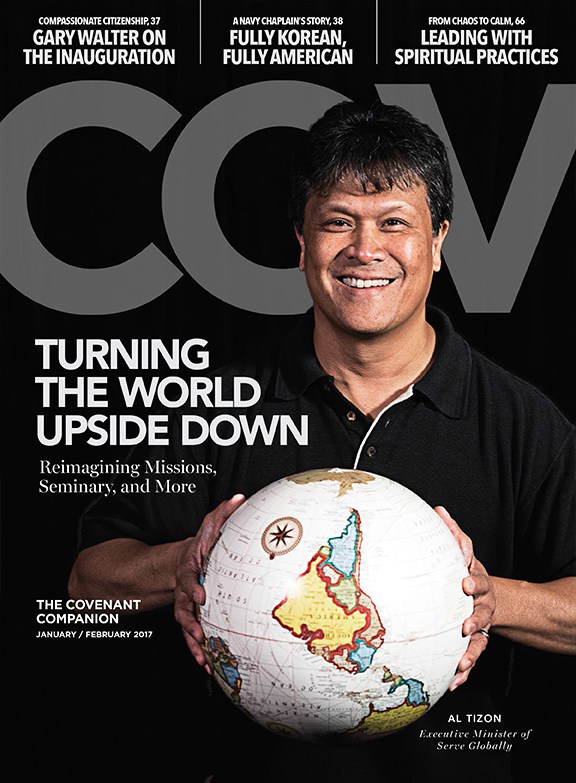ST ANDREWS, SCOTLAND (December 15, 2014) — Editor’s note: Miriam Ernest is a dancer based in New York City and Washington, D.C. She has trained and performed at the Grand Rapids Ballet Company, the Pacific Northwest Ballet School, and other major companies across the continent. She is currently with the Suzanne Farrell Ballet and the Kathryn Posin Dance Company. This year Miriam was nominated for a Princess Grace Award. She was interviewed by her brother, Samuel Ernest for Transpositions, the official blog of the Institute for Theology, Imagination, and the Arts at the University of St. Andrews, Scotland. Miriam Ernest is the daughter of Covenant minister Beth Ernest and her husband, James.
By Samuel Ernest
How does dance intersect with the other parts of your life, including, if you will, faith?
Dancers struggle. Injury, low pay, body image issues, and a sense of self-worth based on casting plague the dance community. The all-consuming nature of dance often limits one’s social life and creates a nagging sense of loneliness. It dictates what we eat, how much we sleep, and usually requires cross training outside the ballet studio. It is exhausting. But my own struggles and feelings of loneliness have prompted me to try to be the best friend I can to fellow dancers because we need each other to survive.
Lately, being a Christian has started to affect how I dance. In Dancing Through It, Jenifer Ringer cites 2 Samuel 6:14, “And David danced with all his might.” The verse doesn’t say, “David danced with technical expertise” or “With a perfect body,” but “with all his might.” It reminds me that God has given me dance to glorify him. Knowing this frees me to joyfully and wholeheartedly use what God has given me, knowing that he is the One I worship—not the mirror, other dancers, directors, or myself.
A few summers ago you attended Alonzo King’s LINES Ballet Summer Program. Alonzo King’s philosophy of dance involves dancing “graciously.” Can you describe what that means?
Alonzo talks about being generous and honest through movement. This means dancing from the inside out instead of just focusing on external poses and positions. Ballet dancers are sometimes afraid of creating ugly shapes with their bodies, and that holds them back from dancing freely and enjoying the movement. If a position is truly inappropriate or technically unacceptable for the choreography, it can be fixed before the performance. But it takes a lot of courage to truly explore a movement, wherever it takes you.
Alonzo also talks about a sort of “monkey see, monkey do” situation that occurs in ballet. Dancers mimic their teachers and choreographers, looking in the mirror to see if they can imitate them perfectly. While it is important to learn from instructors and to be versatile, picking up on intricacies of different types of choreography, a dancer won’t ultimately be successful unless they have the confidence and courage to accept who they are as a person and artist and allow themselves to make mistakes. Dancers are not perfect, they are human. When they realize that, they have the capacity to express so much more.
LINES teaches dancers to look at other dancers and themselves with love—something not taught in the competitive and cutthroat ballet world. Prior to studying at LINES, self-doubt and insecurity often held me back at auditions, classes, and rehearsals. I was making shapes with my body and hoping that they would be acceptable to whoever was watching. Dancing generously and honestly has freed me to love who I am, dance confidently, and try new ways of exploring and moving.
In a recent interview with the Suzanne Farrell Ballet Blog you said, “I firmly believe that dance can be selfless and giving and that there is something deeper to express through this art form.” Do you believe dance is often done selfishly?
I definitely believe that. Many dancers are so career focused that they forget their job is to give to an audience. I have worked with directors who can’t stop talking about their past career, and it holds them back from helping and developing the talent that is right in front of them. Dancing is unique and dancing well is difficult, so many let their skill and expertise get to their heads.
What is that “something deeper” that dance expresses?
Performing is more than looking pretty or fierce in a costume or particular ballet. Dancing is a powerful medium passed down through generations and found in many cultures. It can reveal aspects of the human condition—longing, love, fear, courage, sadness, and joy—and, when an artist’s ego is out of the way, there is room to selflessly explore these in the music and movement, which can resonate with an audience and truly inspire others.
Categories:
News

There is deep understanding and grace in what you have said, Miriam. I am especially blessed by your remark about allowing yourself to make mistakes. That is one of the ways we learn who we are and begin to grow in ways only the Lord can show us. Thank you for sharing!
Very well said, Miriam. I love the way you connect your dancing to the spiritual dimension. Dancers often can be their own worst critics. But when a dancer realizes that she/he can do everything to the glory of God, they become an instrument through which God can bless others and lead them to worship the Creator rather than the created. I wish I could see you dance! What an honor to be nominated for the Princess Grace award!